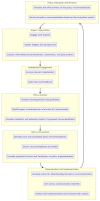Preventing Multidrug-Resistant Bacterial Transmission in the Intensive Care Unit with a Comprehensive Approach: A Policymaking Manual
- PMID: 37627675
- PMCID: PMC10451180
- DOI: 10.3390/antibiotics12081255
Preventing Multidrug-Resistant Bacterial Transmission in the Intensive Care Unit with a Comprehensive Approach: A Policymaking Manual
Abstract
Patients referred to intensive care units (ICU) commonly contract infections caused by multidrug-resistant (MDR) bacteria, which are typically linked to complications and high mortality. There are numerous independent factors that are associated with the transmission of these pathogens in the ICU. Preventive multilevel measures that target these factors are of great importance in order to break the chain of transmission. In this review, we aim to provide essential guidance for the development of robust prevention strategies, ultimately ensuring the safety and well-being of patients and healthcare workers in the ICU. We discuss the role of ICU personnel in cross-contamination, existing preventative measures, novel technologies, and strategies employed, along with antimicrobial surveillance and stewardship (AMSS) programs, to construct effective and thoroughly described policy recommendations. By adopting a multifaceted approach that combines targeted interventions with broader preventive strategies, healthcare facilities can create a more coherent line of defense against the spread of MDR pathogens. These recommendations are evidence-based, practical, and aligned with the needs and realities of the ICU setting. In conclusion, this comprehensive review offers a blueprint for mitigating the risk of MDR bacterial transmission in the ICU, advocating for an evidence-based, multifaceted approach.
Keywords: colonization; healthcare personnel; intensive care unit; multidrug-resistant bacteria; transmission.
Conflict of interest statement
The authors declare no conflict of interest.
Figures
Similar articles
-
Characteristics of Microbial Factors of Healthcare-Associated Infections Including Multidrug-Resistant Pathogens and Antibiotic Consumption at the University Intensive Care Unit in Poland in the Years 2011-2018.Int J Environ Res Public Health. 2020 Sep 23;17(19):6943. doi: 10.3390/ijerph17196943. Int J Environ Res Public Health. 2020. PMID: 32977435 Free PMC article.
-
Accuracy of American Thoracic Society/Infectious Diseases Society of America criteria in predicting infection or colonization with multidrug-resistant bacteria at intensive-care unit admission.Clin Microbiol Infect. 2010 Jul;16(7):902-8. doi: 10.1111/j.1469-0691.2009.03027.x. Epub 2009 Aug 20. Clin Microbiol Infect. 2010. PMID: 19694760
-
Relationship between immunosuppression and intensive care unit-acquired colonization and infection related to multidrug-resistant bacteria: a prospective multicenter cohort study.Intensive Care Med. 2023 Feb;49(2):154-165. doi: 10.1007/s00134-022-06954-0. Epub 2023 Jan 2. Intensive Care Med. 2023. PMID: 36592202
-
Bacterial contamination of inanimate surfaces and equipment in the intensive care unit.J Intensive Care. 2015 Dec 10;3:54. doi: 10.1186/s40560-015-0120-5. eCollection 2015. J Intensive Care. 2015. PMID: 26693023 Free PMC article. Review.
-
Risk stratification and treatment of ICU-acquired pneumonia caused by multidrug- resistant/extensively drug-resistant/pandrug-resistant bacteria.Curr Opin Crit Care. 2018 Oct;24(5):385-393. doi: 10.1097/MCC.0000000000000534. Curr Opin Crit Care. 2018. PMID: 30156569 Review.
Cited by
-
A Multidisciplinary-Based and Bundle Intervention for Controlling Carbapenem-Resistant Organisms in Neurosurgery.Infect Drug Resist. 2025 Feb 6;18:757-768. doi: 10.2147/IDR.S506658. eCollection 2025. Infect Drug Resist. 2025. PMID: 39931038 Free PMC article.
-
Multidrug-Resistant Sepsis: A Critical Healthcare Challenge.Antibiotics (Basel). 2024 Jan 4;13(1):46. doi: 10.3390/antibiotics13010046. Antibiotics (Basel). 2024. PMID: 38247605 Free PMC article. Review.
-
Incidence and Risk Factors of Secondary Infections in Critically Ill SARS-CoV-2 Patients: A Retrospective Study in an Intensive Care Unit.Biomedicines. 2025 May 29;13(6):1333. doi: 10.3390/biomedicines13061333. Biomedicines. 2025. PMID: 40564052 Free PMC article.
-
Antibiotic Resistance and Mortality in ICU Patients: A Retrospective Analysis of First Culture Growth Results.Antibiotics (Basel). 2025 Mar 11;14(3):290. doi: 10.3390/antibiotics14030290. Antibiotics (Basel). 2025. PMID: 40149101 Free PMC article.
-
Editorial for the Special Issue: "The Issue of Multidrug-Resistant Pathogens in Nosocomial Infections".Antibiotics (Basel). 2023 Nov 30;12(12):1683. doi: 10.3390/antibiotics12121683. Antibiotics (Basel). 2023. PMID: 38136717 Free PMC article.
References
-
- Hu H., Johani K., Gosbell I.B., Jacombs A.S., Almatroudi A., Whiteley G.S., Deva A., Jensen S., Vickery K. Intensive care unit environmental surfaces are contaminated by multidrug-resistant bacteria in biofilms: Combined results of conventional culture, pyrosequencing, scanning electron microscopy, and confocal laser microscopy. J. Hosp. Infect. 2015;91:35–44. doi: 10.1016/j.jhin.2015.05.016. - DOI - PubMed
Publication types
LinkOut - more resources
Full Text Sources



